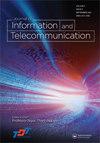Overview of the challenges and solutions for 5G channel coding schemes
IF 2.7
Q2 COMPUTER SCIENCE, INFORMATION SYSTEMS
Journal of Information and Telecommunication
Pub Date : 2021-07-21
DOI:10.1080/24751839.2021.1954752
引用次数: 9
Abstract
ABSTRACT 5G is the next generation of mobile communications networks which will use cutting-edge network technologies to deliver enhanced mobile connectivity. 5G has introduced new requirements for channel coding in its three different service classes which are enhanced mobile broadband (eMBB), ultra-reliable low latency communications (URLLC) and massive machine-type communications (mMTC). eMBB is expected to keep up with consumer’s insatiable demand for high mobile data rates to support data-extensive applications. mMTC will provide connectivity to a massive number of connected devices sending short data packets simultaneously to support applications such as Internet of Things (IoT). Finally, URLLC will ensure reliable low latency connectivity to support mission-critical latency-sensitive applications such as telesurgery. To address these new requirements, several new channel coding schemes are being developed. This review article provides a detailed analysis of the new channel coding challenges set out by 5G. A detailed review of existing and emerging solutions is provided. Moreover, simulation are performed to assess the performances of Low-Density Parity-Check (LDPC) codes and Polar codes used in 5G’s eMBB. Directions for future works and new solutions for 5G channel coding are also discussed.5G信道编码方案的挑战和解决方案概述
摘要5G是下一代移动通信网络,它将使用尖端的网络技术来增强移动连接。5G在其三种不同的服务类别中引入了对信道编码的新要求,即增强型移动宽带(eMBB)、超可靠低延迟通信(URLLC)和大规模机器类型通信(mMTC)。eMBB有望满足消费者对高移动数据速率的永不满足的需求,以支持数据广泛的应用。mMTC将为大量同时发送短数据包的连接设备提供连接,以支持物联网(IoT)等应用。最后,URLLC将确保可靠的低延迟连接,以支持远程手术等任务关键延迟敏感应用。为了满足这些新的要求,正在开发几种新的信道编码方案。这篇综述文章详细分析了5G带来的新信道编码挑战。对现有和新出现的解决方案进行了详细审查。此外,还进行了仿真,以评估5G eMBB中使用的低密度奇偶校验(LDPC)码和极性码的性能。还讨论了5G信道编码的未来工作方向和新的解决方案。
本文章由计算机程序翻译,如有差异,请以英文原文为准。
求助全文
约1分钟内获得全文
求助全文
来源期刊
CiteScore
7.50
自引率
0.00%
发文量
18
审稿时长
27 weeks

 求助内容:
求助内容: 应助结果提醒方式:
应助结果提醒方式:


